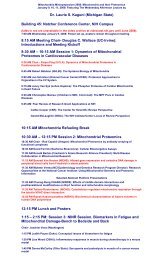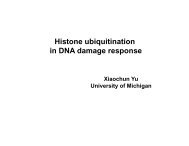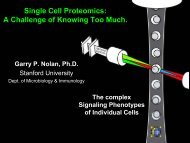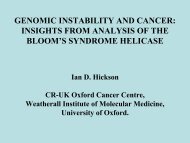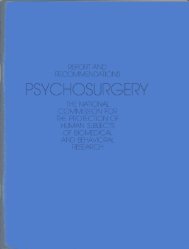RESEARCH ON THE FETUS - National Institutes of Health
RESEARCH ON THE FETUS - National Institutes of Health
RESEARCH ON THE FETUS - National Institutes of Health
Create successful ePaper yourself
Turn your PDF publications into a flip-book with our unique Google optimized e-Paper software.
abnormal values for the responsible enzymes in the cells as the basis for prenatal<br />
diagnosis. This research utilized only amniotic fluid and the fetal cells<br />
in it, and thus was not invasive <strong>of</strong> the fetus. In the early stages <strong>of</strong> developing<br />
the technique, however, the possible risks to the fetus were greater than those<br />
for many invasive procedures.<br />
3. The history <strong>of</strong> Rh isoimmunization disease encompasses the description<br />
<strong>of</strong> the disorder, determination <strong>of</strong> its cause, initiation <strong>of</strong> successful treatment,<br />
and development <strong>of</strong> effective prevention, all within four decades. Characterization<br />
<strong>of</strong> this disorder, which combines hemolytic anemia, jaundice, and intrauterine<br />
death or (if delivered) severe brain damage, was accomplished in the<br />
1930's from study <strong>of</strong> autopsy material and newborn infants. Research on blood<br />
groups, utilizing both human and animal material, led in 1941 to the demonstration<br />
from studies <strong>of</strong> mothers and newborns that Rh sensitization in an Rh negative<br />
mother to an Rh positive fetus produced hemolytic anemia in the fetus. In 1945,<br />
treatment <strong>of</strong> affected newborn infants by exchange transfusion was initiated and<br />
mortality began to decline.<br />
Use <strong>of</strong> amniocentesis was introduced in 1956 to obtain amniotic fluid which<br />
provided an indicator <strong>of</strong> how severely the fetus was affected and, late in pregnancy,<br />
whether labor should be induced to enable treatment <strong>of</strong> the fetus outside<br />
the uterus. In 1963, treatment <strong>of</strong> the severely affected fetus by intrauterine<br />
blood transfusion was initiated, resulting in a 60 percent reduction <strong>of</strong> the<br />
stillbirth rate for affected infants. Ongoing studies <strong>of</strong> the etiology <strong>of</strong> the<br />
disease, using pregnant women, provided indications that sensitization <strong>of</strong> the<br />
mother usually occurred at the time <strong>of</strong> delivery <strong>of</strong> her first Rh positive infant,<br />
when a large volume <strong>of</strong> fetal Rh positive cells entered the mother's circulation.<br />
As the result <strong>of</strong> research conducted largely with prisoners, a vaccine was developed<br />
to prevent this sensitization. Trials <strong>of</strong> the vaccine, administered to women<br />
after delivery, began in 1964. Results indicated virtually complete effectiveness,<br />
and the vaccine (RhoGam) became commercially available in 1968.<br />
Research on the fetus played no part in developing the RhoGam vaccine, but<br />
such research was essential in demonstrating the basic cause <strong>of</strong> the disease and<br />
in developing methods for prenatal diagnosis and treatment. All significant<br />
research on the fetus related to Rh disease was conducted on mothers and fetuses<br />
21



